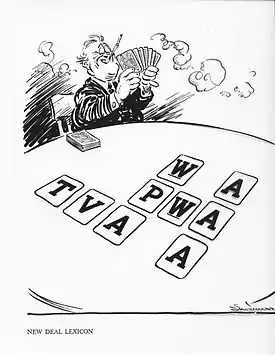Alphabet agencies
The alphabet agencies (also New Deal agencies) were the U.S. federal government agencies created as part of the New Deal of President Franklin D. Roosevelt. The earliest agencies were created to combat the Great Depression in the United States and were established during Roosevelt's first 100 days in office in 1933. In total, at least 69 offices were created during Roosevelt's terms of office as part of the New Deal. Some alphabet agencies were established by Congress, such as the Tennessee Valley Authority. Others were established through Roosevelt executive orders, such as the Works Progress Administration and the Office of Censorship, or were part of larger programs such as the many that belonged to the Works Progress Administration. Some of the agencies still exist today, while others have merged with other departments and agencies or were abolished.

The agencies were sometimes referred to as alphabet soup. Libertarian author William Safire notes that the phrase "gave color to the charge of excessive bureaucracy." Democrat Al Smith, who turned against Roosevelt, said his government was “submerged in a bowl of alphabet soup."[1] "Even the Comptroller-General of the United States, who audits the government's accounts, declared he had never heard of some of them."[2] While previously all monetary appropriations had been separately passed by Act of Congress, as part of their power of the purse; the National Industrial Recovery Act allowed Roosevelt to allocate $3.3 billion without Congress (as much as had been previously spent by government in ten years time), through executive orders and other means. These powers were used to create many of the alphabet agencies. Other laws were passed allowing the new bureaus to pass their own directives within a wide sphere of authority.[2] Even though the National Industrial Recovery Act was found to be unconstitutional, many of the agencies created under it remained.
Partial list of alphabet agencies
Modern era
Since the 1990s, the term "alphabet agencies" has been commonly used to describe the agencies of the U.S. national security state, also known by various three-letter acronyms, and several founded or expanded in the aftermath of 9/11 (2001).[3][4][5][6][7][8][9]
| Initialism | Year | Agency |
|---|---|---|
| ATF | 1972 | Bureau of Alcohol, Tobacco, Firearms and Explosives |
| CIA | 1947 | Central Intelligence Agency |
| DEA | 1973 | Drug Enforcement Administration |
| DIA | 1961 | Defense Intelligence Agency |
| DHS | 2002 | Department of Homeland Security |
| DOJ | 1870 | Department of Justice |
| FBI | 1908 | Federal Bureau of Investigation |
| FEMA | 1979 | Federal Emergency Management Agency |
| ICE | 2003 | Immigration and Customs Enforcement |
| NSA | 1953 | National Security Agency |
| TSA | 2001 | Transportation Security Administration |
Notes
- William Safire (2008). Safire's Political Dictionary. Oxford University Press. p. 15.
- Flynn, John. The Roosevelt Myth, Garden City Books, 1948.
- The Acronym Guide to Federal Agencies | Strategic Consulting Solutions
- Elder, Grant (November 7, 2014). "Wiki vs NWO (New World Order): Moving to Collaboration from Domination". FriesenPress – via Google Books.
- "Seat of Power" – via books.google.ie.
- Attkisson, Sharyl (November 4, 2014). "Stonewalled: My Fight for Truth Against the Forces of Obstruction, Intimidation, and Harassment in Obama's Washington". Harper Collins – via Google Books.
- O'Hara, David J. (January 21, 2003). "Instructor's Manual with Classroom Activities Manual [to Accompany] Economics: Principles and Policy, Ninth Edition". Thomson/South-Western – via Google Books.
- "Defend Yourself Against Criminal Charges" – via books.google.ie.
- Doss, Kevin; Shepherd, Charles (August 17, 2015). "Active Shooter: Preparing for and Responding to a Growing Threat". Butterworth-Heinemann – via Google Books.